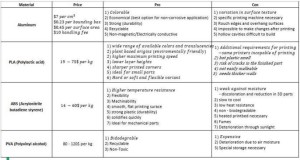Spring 2016 Velociraptor: Material Trade-Off Study
By Mingyu Seo (Manufacturing & Design)
Approved by Khoi Vu (Project Manger)
For the Velociraptor Project, we have considered several materials for manufacturing prototypes as well as for our final robot. The chart shows advantages and disadvantages of the material, to help us consider the different materials we’ll use for the velociraptor:
Through careful consideration, we chose to use 3D material to build our prototype. Using a 3D printer will give use the advantages of faster printing speed, quick solidification, and are easily accessible. 3D materials shown above such as PLA, ABS, and PVA are flexible, strong durability, and have sharp printed corners which are made for ideal small parts. Although the plastic material may have lower temperature resistance compare to Aluminum, building a prototype with a 3D model will let us make adjustments by applying heat to it. We have considered using PLA (Polylactic Acid) material due to its advantages of sharper printing corners, low material cost, maximum printing speed, and accessibility on campus. All 4 materials were considered as a possible material for our final robot. But Aluminum was chosen to be used as the material to build the final robot due to its economical, strong durability and non-magnetic/electrical conductive traits. Due to aluminum’s disadvantages of the necessity of specific printing machine and non-malleability, our team has considered it should be used after finalization of the dimension of our robot in order to minimize cost as well as time.

